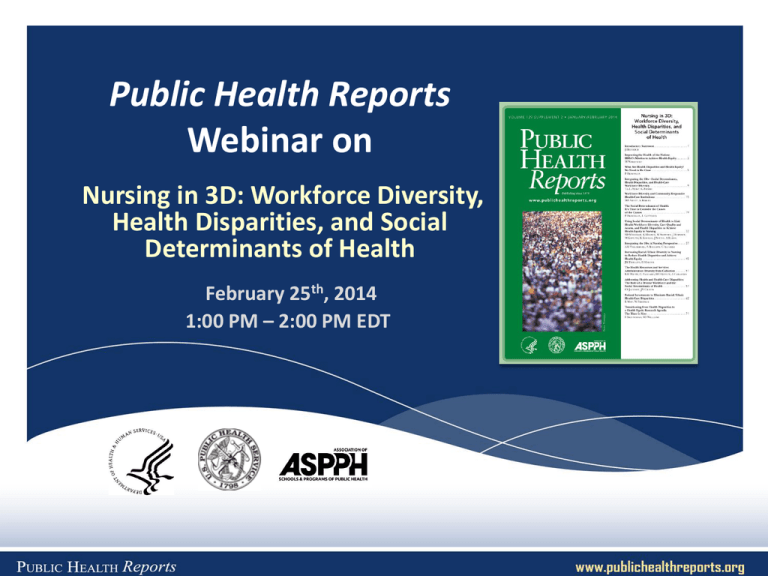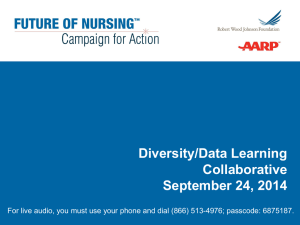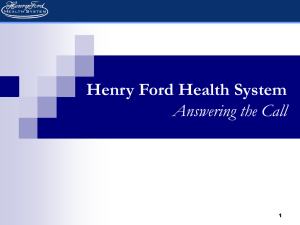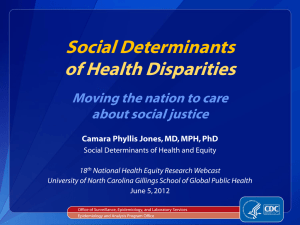health disparities - Public Health Reports
advertisement

Public Health Reports Webinar on Nursing in 3D: Workforce Diversity, Health Disparities, and Social Determinants of Health February 25th, 2014 1:00 PM – 2:00 PM EDT Public Health Reports Webinar on Nursing in 3D: Workforce Diversity, Health Disparities, and Social Determinants of Health Mary Beth Bigley, Dr.P.H., M.S.N., A.N.P. former acting editor of Public Health Reports Director of the Division of Nursing in the Bureau of Health Professions at HRSA Public Health Reports Meet the Author! Live Webcast Nursing in 3D: Transformation from Health Disparities to Health Equity through Workforce Diversity Shanita D. Williams, PhD, MPH, APRN Branch Chief, Nursing Practice and Workforce Development Branch Department of Health and Human Services Health Resources and Services Administration (HRSA) Bureau of Health Professions, Division of Nursing Moving Towards Health Equity: A Collective Effort • The Nursing Workforce Diversity (NWD) Program was legislatively mandated under Title VIII of the 1989 Public Service Act • The NWD Program has awarded $160 million in institutional grants • The nursing community cannot address health disparities and health equity in isolation • Achieving health equity requires a collective effort across all disciplines and all sectors (including outside of health care) • Cross-disciplinary resource that addresses health disparities and health equity Transformation from Health Disparities to Health Equity Nursing in 3D: Workforce Diversity, Health Disparities, and Social Determinants of Health The summit provided nursing stakeholders and grantee communities with the intellectual and conceptual tools necessary to apply the social determinants of health framework to advance the agenda for nursing workforce diversity and health equity. PHR Supplement: Nursing in 3D The supplement: • Includes 11 articles authored by content experts in the fields of nursing workforce diversity, health disparities, and the social determinants of health • Highlights relevant work in federal and private sectors • Presents pathways and partnerships to improve health equity • Increased understanding of potential impact of linking nursing workforce diversity, health disparities, and social determinants • Describes efforts supporting the intersecting goals of: – – – – increased workforce diversity fair and equal access to quality health care and health care resources elimination of health disparities achieving health equity • Provides opportunities to integrate workforce diversity, health disparities, and the social determinants of health – stakeholders (including key federal staff) Nursing in 3D Resources • Nursing in 3D Journal Supplementhttp://www.publichealthreports.org/issuecontents.cfm? Volume=129&Issue=8 • Nursing in 3D Summit Recordingshttp://bhpr.hrsa.gov/nursing/summit.html • Division of Nursing Websitehttp://bhpr.hrsa.gov/nursing/index.html Public Health Reports Meet the Author! Live Webcast Federal Investments to Eliminate Racial/Ethnic Disparities in Health Care Ernest Moy, MD, MPH and William Freeman, MPH (presenting) Staff Service Fellow, Center for Delivery, Organization, and Markets, U.S. Agency for Healthcare Research and Quality Presentation Agenda 1. Health Care Disparities, Is there a Problem? 2. HHS Action Plan to Reduce Racial/Ethnic Health Care Disparities 3. Conceptual Framework: Workforce Diversity’s Role in Disparities and Social Determinants of Health (SDH):How SDH Relate to Health and Health Care Disparities,Role of PatientProvider Communication and Health Care Disparities 4. The Pathway to Equity: Improving Workforce Diversity 5. Tracking Workforce Diversity and HHS/AHRQ Efforts to Improve 6. Implications/Action Items/Prediction for the Future Is there a Problem? Comparisons to the Reference Group Is there a Problem? Health Care Disparities Over Time HHS Action Plan to Reduce Racial and Ethnic Health Disparities Goals and Strategies Action Plan Goals: 1. Transform Healthcare 2. Strengthen the health and human services infrastructure and workforce 3. Advance the health, well being and safety of the American People 4. Advance scientific knowledge and innovation 5. Increase efficiency, transparency, and accountability of HHS programs Application of the plan is alignment in initiatives, research grants and contracts, special programs, and creation of tools and partnerships to reduce disparities through each arm strive towards goals. Conceptual Framework: Health Disparities-Health Care Disparities-Workforce The Pathway to Equity: Improving Workforce Diversity to Blunt HC Disparities How can increasing workforce diversity reduce health care disparities? • Through better patient-provider communication (better adherence to optimal treatment) and improving equity in health outcomes/quality of life – Examples of AHRQ Tools to Improve Patient-Provider Communication and Health Literacy: CAHPS cultural competency modules, CLAS standards, Health Literacy Universal Precautions Toolkit, Pharmacy Health Literacy Center • Though example and providing cross-cultural learning to colleagues can lead to a better understanding and reduce bias, improving patient care. • Though earning higher wages (improving access to care – access to health knowledge/literacy) and improving equity in health (more resources) AHRQ and HHS efforts to improve workforce diversity Tracking and HHS/AHRQ Efforts to Improve Workforce Diversity • Racial and ethnic composition of nursing workforce • THE GOAL: match the workforce composition to the general population Implications for Health and Health Care • Community Health Worker’s Role • Action Items • Predictions Public Health Reports Meet the Author! Live Webcast What is health equity? And how is it linked with the social determinants of health? Paula Braveman, MD, MPH Professor of Family & Community Medicine Director, Center on Social Disparities in Health University of California, San Francisco What are “health disparities” ? • Any differences? Health differences between: – Leg fractures among skiers vs non-skiers? – The elderly vs young adults? – Wealthy people in neighborhood A vs neighborhood B? • Many official U.S. definitions refer only to differences between unspecified groups • But we really mean: Health differences that are unfair (in a particular way) • M. Whitehead: unfair, avoidable, and unjust – But ideas of fairness, avoidability, and justice vary Human rights principles provide guidance • Social & economic rights, including the right to: – achieve the highest attainable standard of health – living standard adequate for health, education, benefits of progress, participation in society • Governments should progressively remove people’s obstacles to fulfilling their rights, especially for those with more obstacles • Non-discrimination & equality: prohibits actions with intent or effect of discrimination & requires affirmative action Human rights principles: Non-discrimination and equality • Specify vulnerable groups: race or ethnic group, skin color, religion, language, or nationality; socioeconomic status; gender, sexual orientation or gender identity; age; disability; geography; political affiliation • Implicit criterion: vulnerability due to history of discrimination, social exclusion or marginalization – Examples: slavery, genocide, hate crimes, expropriation of ancestral lands, targeted marketing of harmful goods, negative media depictions, slurs Defining health disparity & health equity based on ethics and human rights: it’s about justice • Health disparity: a health difference closely linked with social (including economic) disadvantage • Health disparities adversely affect groups who have systematically experienced greater obstacles to health based on discrimination/exclusion; do not need to prove causation • Disparities: the metric to assess progress toward equity • Health equity: pursuing the highest possible standard of health for all while focusing on those with the greatest social/economic obstacles to health Health equity and the social (including economic) determinants of health • Equity in health itself, not only in health care • Human rights principles call for equality and nondiscrimination regarding all rights, including the social determinants of health • Rights to a living standard adequate for health, education, food, water, participation in society, benefits of societal progress How could income affect health? A body of literature supports: Income can shape options for: • Housing • Neighborhood conditions • Diet • Exercise • Services (e.g., childcare, transportation, repairs, medical care…) that can alleviate stress • Most of above can affect stress and thus family stability Parents’ income shapes the next generation’s: • Education • Work • Income Income shapes neighborhood options. How could a neighborhood affect children’s health? • • • • • Safe places to exercise Access to healthy food Ads for harmful substances Social networks & support Norms, role models, peer pressure • Fear, anxiety, despair, stress • Quality of schools • Racial segregation tracks Blacks & Latinos into poorer neighborhoods than Whites of similar income Image: http://www.seattlemet.com/news-and-profiles/publicola/ articles/some-rich-architects-mansion. Childhood social (including economic) conditions shape adult health • Large body of knowledge shows adult health is shaped by early experiences – Lasting effects of in-utero/early childhood deprivation • Early childhood social conditions could have crucial effects not erased by later circumstances – Neuroendocrine and immune dysregulation • Chronic stress/deprivation in childhood chronic disease in childhood and adulthood • Cumulative effects of disadvantage How could racial discrimination damage health? • The legacy of once-legal discrimination: structural racism – lower incomes, wealth, education, occupations • Psychological effects: stress due to economic hardship and racism-related stress – Stress adverse health-related behaviors – Stress direct physiologic damage (via HPA axis, autonomic nervous system, inflammation, immune response, cellular aging) – Not only overt incidents, but subtle experiences & chronic vigilance could damage health Public Health Reports Meet the Author! Live Webcast Increasing Racial/Ethnic Diversity in Nursing to Reduce Health Disparities and Achieve Health Equity Janice Phillips MS PhD FAAN RN Director of Government Affairs CGFNS International Why Diversity • Shifts in demographics minorities- majority by 2043. • Minorities remain underrepresented in nursing. • Essential to addressing health disparities and achieving health equity. • Minority leadership may shape goals, national policies and initiatives on health disparities. Citation: Phillips, J & Malone, B (2014). Increasing racial/ethnic diversity in nursing to reduce health disparities and achieve health equity. Public Health Reports, 129, 45-50. Unfinished Business • What are the contributions of minority nurses in eliminating health disparities? • How will increasing the number of minority nurses with advanced degrees aid in achieving health equity? • Where are our minority nurse leaders positioned? Beyond the Bedside • Schmeidling, NJ (2000). Minority Nurses in Leadership Positions: A Call for Action. Nursing Outlook 48(3), 120-127. Path to Strengthening Social Determinents • Integrate and establish stronger linkages SED in all levels nursing education. • Support specific training in health equity and disparities for all levels of nursing including APRN. Citation: Phillips, J & Malone, B (2014). Increasing racial/ethnic diversity in nursing to reduce health disparities and achieve health equity. Public Health Reports, 129, 45-50. Path to Strengthening Minority Contribution • Create stronger metrics that assess minority nurses’ contributions in this arena. Need common language and common metrics. • Create national repository to showcase efforts. • Work with ethnic minority organizations to collect data on leadership positions and related activities. Citation Phillips, J & Malone, B (2014). Increasing racial/ethnic diversity in nursing to reduce health disparities and achieve health equity. Public Health Reports, 129, 45-50. An Exemplar • Newly funded Duke University School of Nursing Health Equity Academy (HRSA Diversity Grant) • Emphasis on the Social Determinants of Health View the HEA Informational Webinar The Duke University School of Nursing announces The Academy for Academic and Social Enrichment and Leadership Development for Health Equity (Health Equity Academy). The Health Equity Academy (HEA), a newly funded Health Resources and Services Administration (HRSA) Nursing Workforce Diversity grant (D19HP25902), is the next generation of the Making a Difference in Nursing II (MADIN II) program. MADIN II concludes December 31, 2013. The Health Equity Academy will focus on Social Determinants of Health (SDH), health access, health disparities, diversity and health equity in the preparation of HEA Scholars destined to become the next generation of minority nurse leaders. Selected Resources • Doctoral Advancement in Nursing (DAN) Project • AACN and RWJ Foundation initiative to enhance minority nurses completing PhD and DNP degrees. White paper: http://www.newcareersinnursing.org/resources/da n-white-paper • U. S. Department of Health and Human Services, Health Resources and Services Administration, Bureau of Health Professions Diversity Grant Programs http://bhpr.hrsa.gov/grants/diversity Questions? Closing For more information about PHR, visit at: www.publichealthreports.org This Webinar will be archived for future reference at http://www.publichealthreports.org/webinars.cfm 1 CPH re-certification credit is available for participating in this webinar. To learn more about the Certification in Public Health program (CPH), please visit https://www.nbphe.org/.








